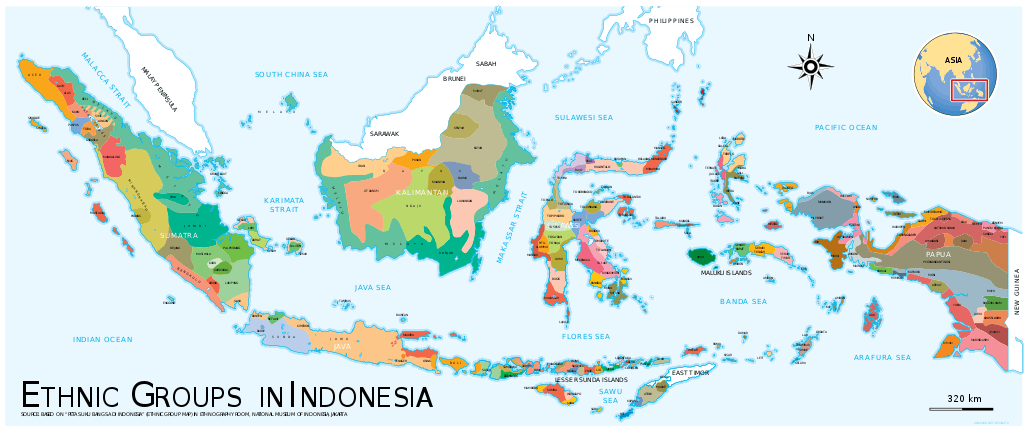Ethnic groups in Indonesia
There are 633[1] recognised ethnic groups in Indonesia. The vast majority of those belong to the Austronesian peoples.
| Part of a series on the |
| Culture of Indonesia |
|---|
 |
| History |
| People |
| Languages |
| Cuisine |
| Literature |
|
Music and performing arts |
|
Media
|
| Sport |
|
Monuments |
|
Based on ethnic classification, the largest ethnic group in Indonesia is the Javanese who make up about 40% of the total population. The Javanese are concentrated on the island of Java but millions have migrated to other islands throughout the archipelago because of the transmigration program.[2] The Sundanese, Batak, Madurese, Minangkabau, and Buginese are the next largest groups in the country.[2] Many ethnic groups, particularly in Kalimantan and Papua, have only hundreds of members. Most of the local languages belong to the Austronesian language family, although a significant number of people, particularly in eastern Indonesia, speak unrelated Papuan languages. Chinese Indonesians make up a little less than 1% of the total Indonesian population according to the 2000 census.[2] Some of these Indonesians of Chinese descent speak various Chinese dialects, most notably Hokkien and Hakka.
The classification of ethnic groups in Indonesia is not rigid and in some cases unclear due to migrations, cultural and linguistic influences; for example some may consider Bantenese and Cirebonese to be members of the Javanese people; however, some others argue that they are different ethnic groups altogether since they have their own distinct dialects. This is the same case with Baduy people that share many cultural similarities with the Sundanese people. An example of hybrid ethnicity is the Betawi people, descended not only from marriages between different peoples in Indonesia but also with Arab, Chinese and Indian migrants since the era of colonial Batavia (Jakarta).
Statistics
2010
Number and percentage of population of ethnic groups with more than a million members according to the 2010 census.[3][lower-alpha 1]
The proportions of Indonesian ethnic groups according to the (2000 census) are as follows:[4] Note that some ethnic groups that some now recognized ethnic groups were subsumed under larger umbrella groups up until 2001. Since the 2010 census they are counted separately.

Indigenous ethnic groups

The regions of Indonesia have some of their indigenous ethnic groups. Due to migration within Indonesia (as part of government transmigration programs or otherwise), there are significant populations of ethnic groups who reside outside of their traditional regions.
- Java: Javanese (Tenggerese, Osing, Banyumasan, etc.), Sundanese (Bantenese, Badui), Betawi
- Madura: Madurese
- Sumatra: Malays, Batak, Nias, Minangkabau, Acehnese, Lampung, Kubu
- Kalimantan: Dayak, Banjar, Malays
- Sulawesi: Makassarese, Buginese, Mandarese, Minahasan, Toraja, Bajauan
- Lesser Sunda Islands: Balinese, Sasaki, Sumbawan, Dawan, Tetunian, Helong, Roti, Savu, Sumban, Alorese, Floresian
- Moluccas: Alfur, Nuaulu, Manusela, Wemale, Tanimbarese
- Papua: Dani, Bauzi, Asmat, Amungme
Foreign ethnicities
Throughout Indonesian history, waves of migration of foreign origin ethnicities were spread throughout Indonesia, usually inhabiting urban centres and seldom reaching rural parts of Indonesia.
- Chinese: The most significant ethnic minority of foreign origin in Indonesia, populating around 2,8 million officially, the other sources estimated are around 8 to 12 million. Chinese began inhabiting Indonesia since the 15th century with significant waves in 18th and 19th century. Mostly concentrated in pecinan (chinatowns) in urban Java, Sumatra and Kalimantan cities with significant numbers in Jakarta, Surabaya, Tangerang, North Sumatra, Riau, Riau Islands, Bangka-Belitung Islands, and West Kalimantan.
- Arabs: Historically Arab traders were responsible for the spread of Islam in the Indonesian archipelago. Many have assimilated into local ethnicities such as Betawi, Malay, Javanese, and Sundanese; however, several cities in Indonesia have significant Arab populations that preserve their culture, identity, and their links to Arabic countries. Spread throughout Indonesian cities, significant numbers can be found in Palembang, Banda Aceh, Padang, Jakarta, Surabaya, Gresik and many coastal cities in Indonesia.
- Indian: Indian people also had settled the Indonesian archipelago; however, their number is not as large as that of Chinese Indonesians. Concentrated in urban centres with significant numbers around Pasar Baru in Jakarta, and the most known at Kampung Madras in Medan, almost 80% of all Indians Indonesians are living in the province of North Sumatra.
- Indos: Indos or Eurasians, of mixed ancestry between Indonesian native ethnic groups and European/Dutch ancestry, they emerged during the Dutch East Indies period. Around one million Indonesians with various degrees of mixed ancestry today can trace their ancestry to Europeans. During the colonial period, their numbers were greater, but since Indonesian independence most chose to go to the Netherlands. Eurasian Indonesians dwindle in number as an ethnic group since major emigration from Indonesia after World War II, mostly Indos or Eurasians today living in Jakarta, many of them has dual or renounce its citizenship to other countries. As of 2011, estimated 124,000 Indos live outside Netherlands (including Indonesia).[5]
- Mardijker: The name means "freeman" and derives from Dutch pronunciation of the Malay word "merdeka", meaning "free". The ancestors of the Mardijkers had been slaves of the Portuguese in India, Africa and Malay Peninsula. They were brought to Indonesia by the Dutch East India Company and freed after their settlement. Over a great length of time they would eventually be absorbed into the larger Indonesian community, though a neighborhood, Kampung Tugu, still exists today and retains its own distinct culture characteristic of the Mardijker peoples.
- Japanese: Japanese have migrated to Indonesia since the Dutch East Indies colonial era; however, after their defeat in World War II, their number decreased, leaving small numbers of ex-Japanese soldiers that still stayed in Indonesia and became Indonesian citizens. The recent development of Japanese residents in Indonesia was driven by the increase of Japanese business and investment in Indonesia since the 1970s, and mostly are expatriates that still maintain their Japanese citizenship. Significant numbers of Japanese expatriates stay in Indonesia, especially in Jakarta and Bali.
- Korean: They are a recent addition of Indonesian foreign origin ethnicities, dated back only several decades ago. Mostly driven by the increase of Korean business and investment in Indonesia, and most are expatriates that still maintain their Korean citizenship.
- Pakistanis: There are hundreds of Pakistanis in Indonesia, mainly of Punjabi origin, who work in various textile and rice production industries. Statistics from the Overseas Pakistanis Foundation in 2004 outlined as many as 400[6] although numbers have grown; roughly 100 Pakistani families reside in Jakarta and another 300 in other cities. Additionally, there is a large second and third generation of individuals, originally descendants of Pakistani soldiers who came to fight in 1945 as part of the British Indian Army alongside the Indonesian military against the Axis forces and the Japanese.[7]
See also
References
Notes
- Ethnic classification follows the New Classification presented in Ananta et al. 2015, based on raw data from the 2010 census.
Citations
- "Mengulik Data Suku di Indonesia". Badan Pusat Statistik. 18 November 2015. Retrieved 12 February 2020.
- Suryadinata, Leo; Arifin, Evi Nurvidya; Ananta, Aris (2003). Indonesia's Population: Ethnicity and Religion in a Changing Political Landscape. Institute of Southeast Asian Studies. ISBN 9789812302120.
- Ananta et al. 2015, pp. 119–122.
- Leo Suryadinata, Evi Nurvidya Arifin, Aris Ananta; Indonesia's Population: Ethnicity and Religion in a Changing Political Landscape, 2003
- Beets, Gijs; van Imhoff, Evert (2004). "A Demographic History of The Indo-Dutch Population, 1930–2001" (PDF). Journal of Population Research. p. 47-72. doi:10.1007/BF03032210.
- Overseas Pakistanis Foundation - 2004 Yearbook Archived 2010-05-24 at the Wayback Machine
- My Jakarta: Maj. Gen. (ret.) Ali Baz Archived 2012-05-03 at the Wayback Machine - The Jakarta Globe
Bibliography
- Ananta, Aris; Arifin, Evi Nurvidya; Hasbullah, M Sairi; Handayani, Nur Budi; Pramono, Agus (2015). Demography of Indonesia's Ethnicity. Institute of Southeast Asian Studies. ISBN 978-981-4519-87-8.CS1 maint: ref=harv (link)
